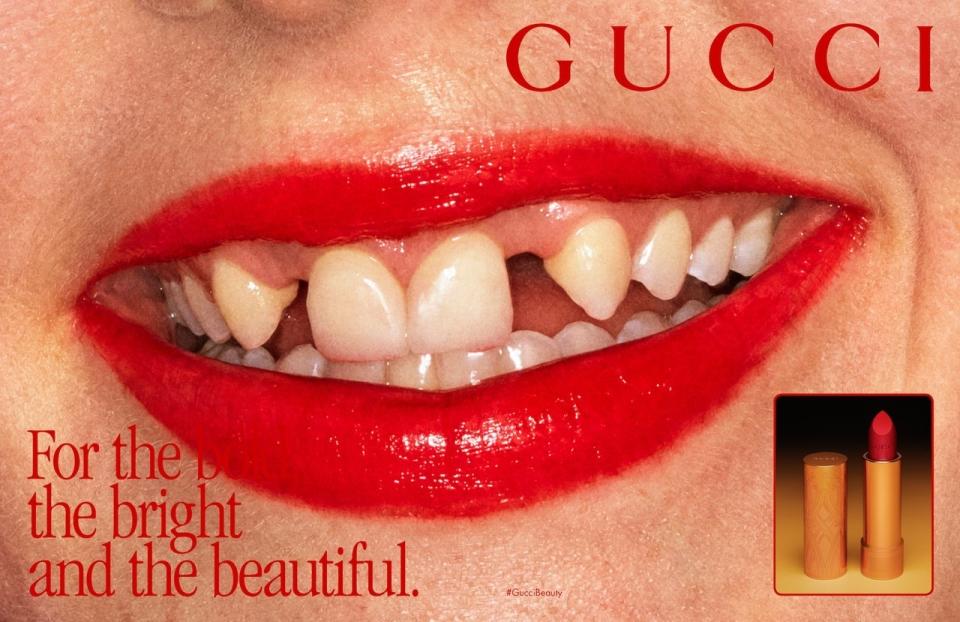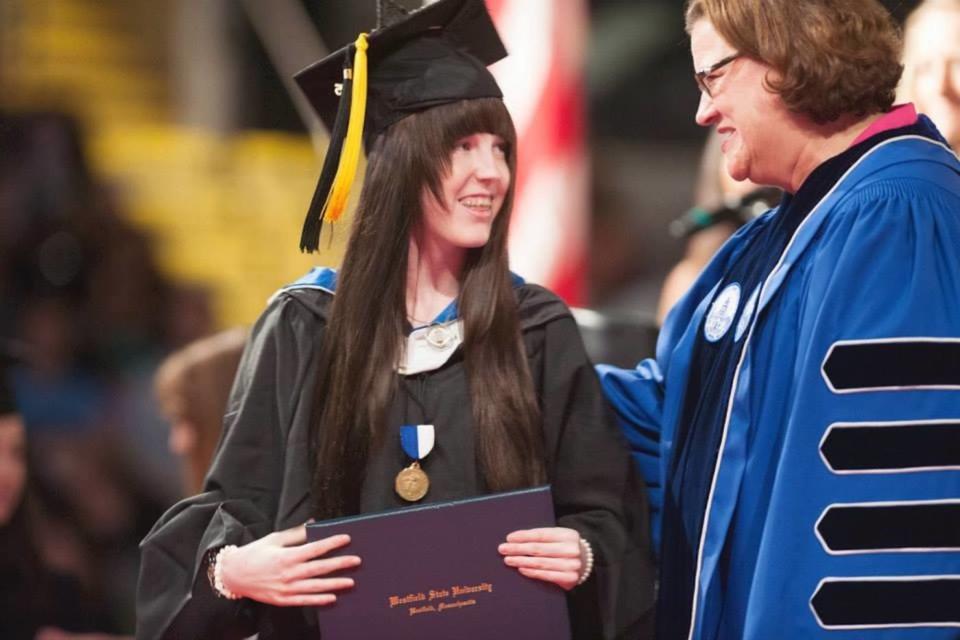The Reaction to Gucci’s Ad Doesn’t Surprise Me—I Grew Up With ‘Bad Teeth’
“Your clothes are from Kmart,” sneered a classmate as she passed my locker. “And your teeth are crooked!”
I snapped my mouth shut immediately.
It was the spring of sixth grade, and even though I’d been poor my entire life, it was the first time I’d ever been mocked for it. My clothes, while the most affordable option for my cab driver single dad, were something I could change with the help of the sales rack and a little ingenuity. My teeth were not. They were crowded in places with gaps in between several of them. I had a significant overbite and a chip on the bottom one of my front teeth. They were one of the first things people saw when I’d introduce myself, and I was completely ashamed of them.
After that day I stopped going to my locker to get my books and instead carried them around all day in my backpack. I didn’t give anyone else an open invitation to mock me in the halls, away from the protection of a teacher’s presence. It wasn’t until eighth grade, when another classmate pointed out that my teeth had an “ugly” overbite, that I refused to show them in pictures anymore.
It stayed that way until I was 17, when after years of making appeals to state-funded health care, my dad finally got approval for me to get braces. That meant he wouldn’t have to worry about the copays and could instead pay off the other bills (rent, car, cable, Internet) we were already late on.
The day I got them off, just after my college graduation, I sent out selfies to all my closest friends. “You’re beautiful!” “They look incredible!” “I can’t believe those are your teeth!” my friends texted back. I wanted to say my insecurity about how my teeth looked had stolen years of my smile from photos. Or that I’d never felt the sharp contrast of poverty as much as I had when I sat in that orthodontist’s office among kids and teenagers who could afford to get treatment earlier. What I said was "Thank you, I’m glad it’s finally over."
Despite the struggle it took to get there, I consider myself one of the lucky ones. There are still plenty of women who don’t have access to, can’t afford, or haven’t gotten orthodontia, which became a heated discussion this week when Gucci Beauty launched its new lipstick campaign. One of the ads, which features model and singer Dani Miller, proudly shows the large gaps in her teeth behind a scarlet-drawn smile. Nothing was retouched or edited to look “perfect”—it was Miller’s joyous grin in all its natural glory.

Miller told Glamour she used to be bullied for her teeth (she was born missing her front incisors) and that she’d begged her mom for teeth implants growing up. Eventually, though, she began to embrace her smile as it was. "I hope the ad inspires and reassures people around the world to find confidence and know that it’s OK to be themselves even more," she tells Glamour. "Let go of the pressures of traditional beauty and perfection. Your unusual features are powerful and beautiful."
Research shows that we have negative associations with smiles outside the conventional norm—gaps between teeth, crooked teeth, teeth that aren’t white, or missing teeth. For example, one recent study found Americans perceive people with straight teeth as 58 percent more likely to be successful. People with so-called perfect smiles are also more likely to be perceived as happy, healthy, trustworthy, and smart.
Reactions to Gucci’s campaign have been mixed. While many responses have been positive, others have commented that they feel these images promote unhealthy habits or that they won’t make anyone want to buy the lipstick.
I personally can’t say I’m surprised. Bad teeth are one of America’s universal signs of poverty. According to the National Association of Dental Plans, in 2016, two thirds of Americans with dental insurance had private dental insurance, which is generally employer-funded or paid for out of pocket. Private insurance is often not an option for poor people, which is why I had to wait to get braces until I was a senior in high school—long after the majority of my peers.

The reaction to this campaign shows that there’s still a lot of work to do in destigmatizing dental work. When I opened up about my teeth insecurity to my friends in high school, several of them asked me why I didn’t just get braces like most of our classmates had already done. I was too ashamed to admit that I was on public health insurance and my family couldn’t afford the out-of-pocket costs. We applaud models with "cute" gaps in their teeth, like Slick Woods and Georgia May Jagger, because their smiles still basically fit into conventional beauty ideals; the gap is small and in the middle of a row of otherwise straight white teeth. But as many of these models have shared throughout their careers, even that acceptance—and brands' giving them the opportunity to showcase their beauty—took time.
A campaign like Gucci’s could have had a profound effect on how I saw myself as a teenager, and especially on how my classmates and friends saw me. Research from Florida State University shows that seeing images of models who share your body type can increase self-worth and satisfaction and make you less likely with compare yourself to others. It’s not a big leap to assume the same can be said of teeth.
The shame I felt about my smile was demoralizing. If I’d seen more crooked teeth and “awkward” gaps, maybe I wouldn’t have been so embarrassed that I once asked a girl I kissed if my teeth were “getting in the way.” Actors in the TVs shows and movies I watched always had perfectly straight white smiles and didn’t have to worry what their love interests thought about their teeth. I knew I’d never have a smile like Cassie Steele’s Manny Santos on Degrassi: The Next Generation or Hilary Duff’s Lizzie McGuire.
Maybe if there were more examples of imperfect teeth reflected in media, there would be less pressure to spend an average of $3,000 to $7,000 on braces or to go into debt to fund cosmetic dental treatment.
It’s notable that a luxury brand like Gucci is choosing to showcase imperfect teeth so prominently when most people perceive straight white teeth as a sign of wealth. Some people have criticized Gucci, saying the brand did this campaign for shock value. Gucci, which is valued at $22.4 billion, has the privilege to take risks like highlighting unconventional smiles, even if it upsets some customers. When a luxury brand like Gucci embraces visible markers of poverty in their campaigns, they are paving the way to breaking down existing stereotypes associated with imperfect smiles. If crooked teeth are seen as a luxury in Gucci’s eyes, maybe we’ll start to see them reflected more on TV and in other forms of media.
I’m both grateful that a high-profile brand is giving more people a reflection of their own smile and skeptical that a luxury brand is toting inclusivity with teeth that are not typically associated with wealth and financial privilege. The least expensive item in the handbag section of Gucci’s online store is a detachable leather strap for $230. When I was poor, my dad and I could barely afford to spend that much on basic necessities, never mind a handbag strap. The only brand-name purse I had in high school was a colorful Dooney and Bourke gifted to me by my neighbor because her granddaughter didn’t want it.
Gucci’s campaign pays lip service to inclusion and imperfection, but many poor people probably won’t be buying the Goldie Red Rouge à Lèvres satin lipstick that Miller wears in the campaign for $38 a piece. Before she died, leaving my dad to raise me on his own, my mom rarely wore lipstick. But when she did, we’d walk from our home in the projects to the nearby CVS and she’d spend no more than $5 on a tube. Even now with a larger disposable income, the most I’ll usually spend is $20 on lipstick for my fiancée.
My teeth are still off-white and a little yellow in places. I’ll catch myself eyeing them in the mirror or surveying their faults in a photo, since I now smile and laugh openly when the camera is out. A few weeks ago I was surrounded by ads for Candid, a company that sells clear aligners shipped directly to customers, while I was boarding the red line at South Station in Boston. “Let’s talk about your teeth,” the ads read. I found myself thinking, Should I order these and see if my teeth can get any straighter before my wedding in September? Direct mail retainers like Candid, which was founded in 2017, weren’t an option when I was a teenager, and I know that even the $80 monthly payments would have been difficult for my family.
I pushed those thoughts away. My fiancée doesn’t love me because she wants me to continue molding myself into an idealized version of the person I dreamed of being. She loved me when I had adult braces and bought my flip-flops for $5 at Payless.
I just need to remember to love that person too.
Alaina Leary is an editor, journalist, and activist from Boston. She's currently the editor of Equally Wed Magazine and the communications manager for the nonprofit We Need Diverse Books.
Originally Appeared on Glamour

